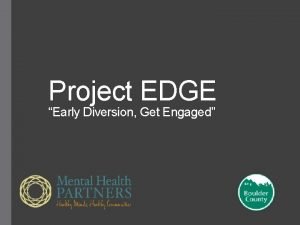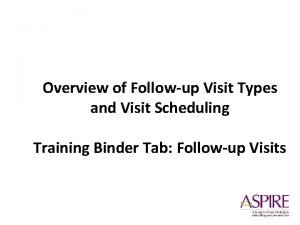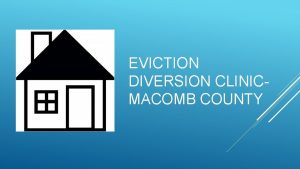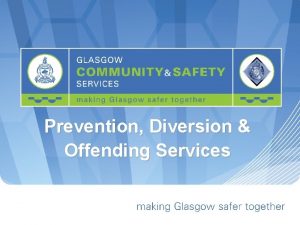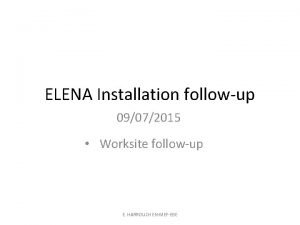Project EDGE Early Diversion Get Engaged FollowUp Care


















- Slides: 18

Project EDGE “Early Diversion, Get Engaged”

Follow-Up Care Cost Avoidance Estimated total cost avoidance between $605, 447 – $721, 286 annually Without an EDGE encounter… If 87% result in a 1 day jail stay • 631 encounters • $57, 919 avoided cost per year If 87% result in a 3 day jail stay • 631 encounters • $173, 758 avoided cost per year If 3% result in a 6 month jail stay • 22 encounters • $367, 527 avoided cost per year If 10% result in a 3 day psychiatric hold • 72 encounters • $180, 000 avoided cost per year

Total Annual Costs Avoided by EDGE Intervention: On-Scene and Follow-Up Care Cities of Boulder and Longmont • $1, 672, 248 Expanded reach to Other Areas in Boulder and Broomfield Counties • $1, 256, 175 Boulder and Broomfield Counties Combined • $2, 928, 423

Total Numbers Served The first 9 months of the program

Total Numbers Served 1, 450 encounters (Target 1, 060) as of 3/31/16 1600 1400 1200 1000 800 600 400 200 0 Mar-14 Jun-14 Sep-14 Dec-14 Mar-15 Jun-15 Sep-15 Dec-15 Mar-16 Enounter Total Target

Visible Advantages of EDGE • Early Diversion: reduced incarcerations • SME (Subject Matter Expert) on scene • EDGE can offer follow up; it’s not just a crisis service. • Some respondents react poorly to the uniform • Cost Savings: jail, hospital, EMS transport; high utilizers, etc • Demonstrates good faith effort that LE has used every tool at our disposal • Access to a persons entire documented mental health history: more accurate and informed interventions

Visible Advantages of EDGE, cont’d • SME can reassure that current efforts are hopeless—time to go hands on—or offer a different path forward that LE can’t see • Ability to track people as they “enter the system” i. e. , enroll in services, follow-up with prescriber, etc. (Important for diversions: we can follow up to ensure that the agreement is followed).

Hidden Advantages/Unexpected Benefits of EDGE • Change in LE officer’s attitude toward behavioral health issues • Change in community (and mental health staff!) attitude toward LE • Increased confidence in outcomes: second opinion from SME • Improved communication and collaboration amongst all emergency services • Reduced use of force; and, reduced transports increase safety • Reduction in high utilizer problem • Better job satisfaction for LE officers • We are still learning these benefits!

Challenges and Expected Pitfalls • FUNDING. Surprise! • Compliance with confidentiality law; we can’t talk to you! • LE engagement; takes time, and a program that says yes, not no. • Mental health worker drive and initiative; you need go-getter staff • Safety: Go-getter staff tend to take risks. Wear a vest? A completely secure scene reduces the value; de-escalation has already happened. • Mental health workers turn into cops over time • Response time: is your jurisdiction large or rural? • Collecting data to accurately demonstrate outcomes: it’s hard to measure what would have happened if EDGE wasn’t there

Challenges and Expected Pitfalls, Cont’d • What resources are available to you? Is your area rural or less developed, with limited referral options? Even if that’s the case, intervention can change outcomes and reduce transports. Many times, the needed service/referral doesn’t exist. • We don’t have effective treatment for all conditions.

Building a Program

Grants • This is a hot topic right now • Grants are available, but competition is stiff • Grants allow a program to prove its worth before permanent local program funding • That is how EDGE started, and grants still augment the program • Collect data not just for the grant, but also to plan for sustainability

Community Funding • Is your community ready? How do we get there? Pull everyone together: Dispatch Fire EMS Municipalities (LE and government) Counties (Sheriff and government) Demonstrate the value: Consultants/speakers (EDGE loves to consult!) Research existing programs, show data, est. cost reductions Point out qualitative goals that we can’t measure: improved quality of life for the community

Who pays? • Many stakeholders benefit from the cost savings: Law enforcement Hospitals Emergency Medical Service (Ambulance) Jails How do we decide what an appropriate share is from each stakeholder? • Multiple municipalities: how is proper contribution determined?

Contract with a CMHC (Community Mental Health Center), or Create Your Own Internal Department? • Creating an internal department solves: Communication issues, like health privacy law You do your own corrective actions, solve your own personnel issues You hold your own trainings, create your own protocols • However, other issues arise: Who supervises clinical staff? Crisis workers become cops, reducing the value of collaborating Much of the advantage is in collaboration between agencies Clinicians need malpractice insurance; CMHCs already have that.

Peer Support • An essential part of the EDGE program • Lived Experience • Follow up after the fact; on-going relationships • Different boundaries; they form a a different kind of bond. • Some folks don’t like the uniform? Some folks don’t like to be told they are mentally ill, either!

Set Realistic Limits and Expectations • To whom are these services available? • Under what circumstances? • Should you allow appointments to be made? If so, how will you respond to emergencies during that time? • Will your service stand by for “just in case”, or do you want a confirmed crisis before dispatch? • If you don’t set limits, you will get caught up in non -crisis chronic problems, and not be available for real emergencies

Project EDGE “Early Diversion, Get Engaged” Charlie Davis, Supervisor cdavis@mhpcolorado. org 303 -563 -9197
 Followup edge
Followup edge Get on / get off transport
Get on / get off transport Followup:actionitems
Followup:actionitems Follow up visit
Follow up visit One direction songs with alliteration
One direction songs with alliteration Rising edge and falling edge
Rising edge and falling edge Primary secondary and tertiary health care
Primary secondary and tertiary health care Marc exports
Marc exports Trade diversion and trade creation
Trade diversion and trade creation Diversion uses and gratification
Diversion uses and gratification Umich
Umich Republic act no. 9344 is otherwise known as: *
Republic act no. 9344 is otherwise known as: * Trade diversion and trade creation
Trade diversion and trade creation Syphon aqueduct
Syphon aqueduct Drug diversion investigator
Drug diversion investigator Drug diversion investigation checklist
Drug diversion investigation checklist Diversion mechanism
Diversion mechanism Trade diversion and trade creation
Trade diversion and trade creation Upper lobe blood diversion
Upper lobe blood diversion
